I love it when process art gets all mixed up with science. Oil and water painting does just that. It’s all about the process, but it also teaches physical science properties to preschoolers.
It’s a matter and mixtures activity (yeah, that’s chemistry) that combined with some watercolors makes a beautiful piece of frame-worthy art.
Or is it science? Frame-worthy science?
Teach Matter and Mixtures with Oil and Water Droplet Painting
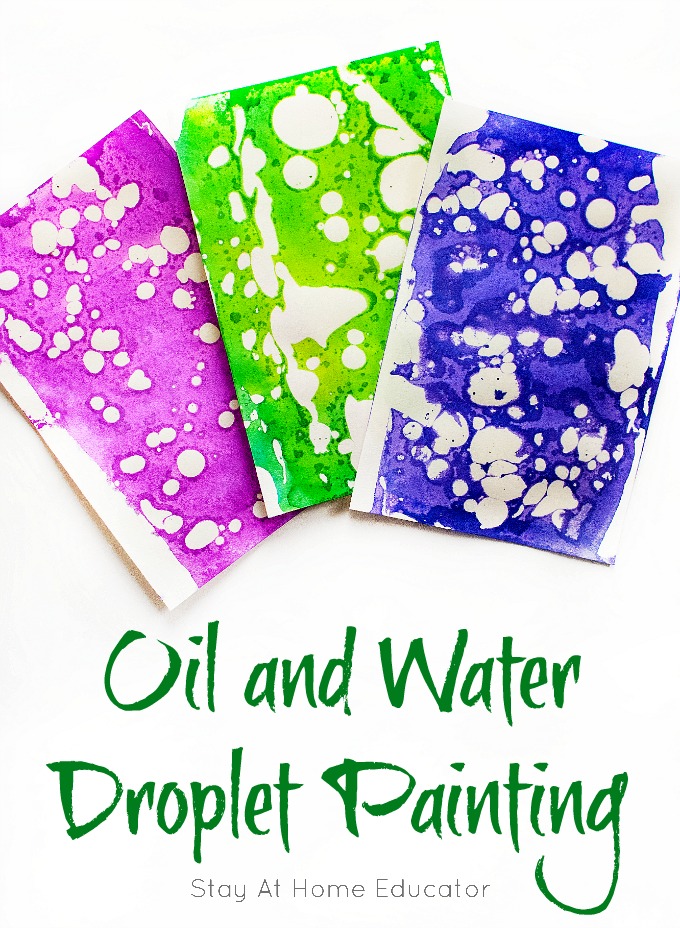
This activity came about on one of those days where it seemed like we had exhausted all our usual go-to activities.
It was the middle of summer. The middle of summer when you love having your kids home but also wish they were at school because suddenly you’re remembering what it feels like to have all five of them around you.
All. The. Time.
The kids were bored with playing outside. They were bored playing inside. Bored with Legos and Snap Circuits. They were bored with the doll house and the Rody Pony.
They were…well…bored.
And you know what boredom leads to.
Trouble. And whining. And hounding.
Mom racking her brain for something quick and easy to throw together to get her little critters from clinging to her legs all day long. Because with five kids sometimes I’d really rather not be touched. At. All.
You know the feeling.
-
Product on sale
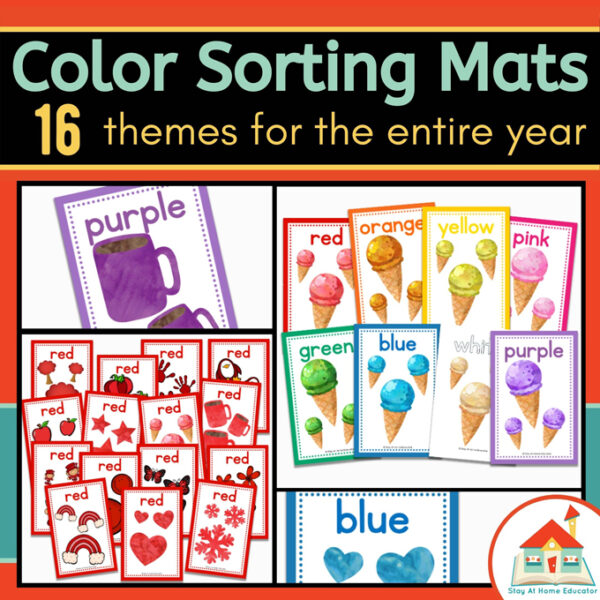 Color Sorting Mats for the Entire YearOriginal price was: $16.00.$8.00Current price is: $8.00.
Color Sorting Mats for the Entire YearOriginal price was: $16.00.$8.00Current price is: $8.00. -
Product on sale
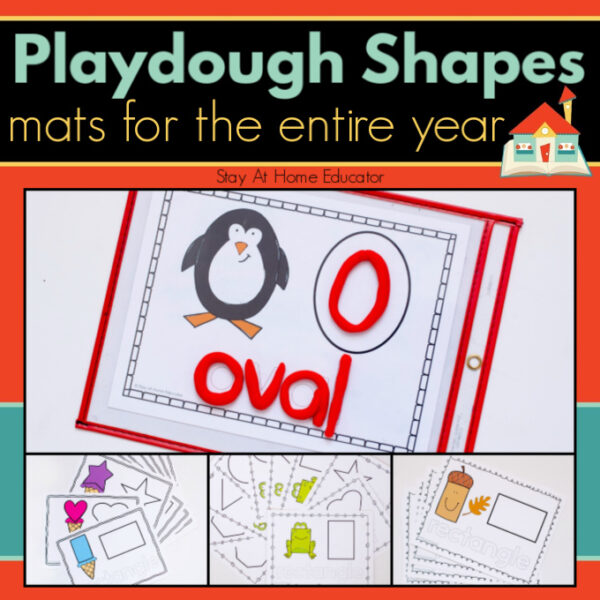 Playdough Shape Mats for the Entire YearOriginal price was: $12.00.$8.00Current price is: $8.00.
Playdough Shape Mats for the Entire YearOriginal price was: $12.00.$8.00Current price is: $8.00.
It was one of those days…and thank goodness for that!
Because had it not been one of those days, I would not have thought up this beautiful process art activity that is a science activity in disguise.
Who knew a matter and mixtures activity would turn into such lovely thank-you cards?
FAQ About Doing Science With Preschoolers
Like most preschool activities, science in preschool is best taught using hands-on, inviting activities. Preschoolers respond really well to science activities that allow them to explore and ask questions. Often these projects can get messy or loud, but that is just part of the scientific process for a preschooler.
Be inviting of your preschooler’s curiosity and explore possible answers with your preschooler.
Science activities help preschoolers develop a sense of wonder and curiosity. In addition, science also teaches other life skills like:
~ communication
~ vocabulary
~ organization
~ data analysis
~ social skills
~ measuring skills
~ predication skills
This oil and water droplet painting is certainly one of our favorite preschool science activities. Here are some other high-interest and playful activities:
~ Cellophane Collages
~ What Does Yeast Eat?
~ Gravity Drop
~ Fall Science Center
~ Observing Seeds
Additionally, you can also try any of these 15+ STEM activities for preschoolers.
Related Combined Science and Art Activity
More About STEM in Preschool
How to Make Oil and Water Painting Process Art
Oil and water painting is the result of mixing cooking oil and colored water to create a beautiful, spotty, slightly marbleized effect. You can find such paper at a craft or stationary store, or you can invite your kids to help you make some of your own, which is tons more fun and tons more frugal.
And it’s a boredom buster.
The process is very simple, as process art should be. And sometimes those are the best science activities, too!
So simple, in fact, that even young toddlers can give it a try and still produce a colorful and beautiful piece of artwork. Yes, even older elementary school kids love it.
Materials
- shallow baking dish
- cooking oil
- liquid watercolor (or water dyed with food coloring)
- heavy paper (sketch paper will do, but watercolor painting paper is even better)
- drying rack (ha, or a cookie rack will work)
- eye droppers or pipettes (Pipettes will give you smaller spots of oil).
STEM Materials In My Preschool Classroom
The Set-Up
Place a small amount of liquid watercolor in the bottom of a shallow, rectangular baking dish. Pour a bit of oil into a smaller bowl, maybe a quarter a cup is all.
Have your cookie rack set out and ready to collect the papers as they are made. Since the papers will come out very wet using this painting technique, it’s a good idea to have a cookie sheet or old towel under the drying rack.
-
Product on sale
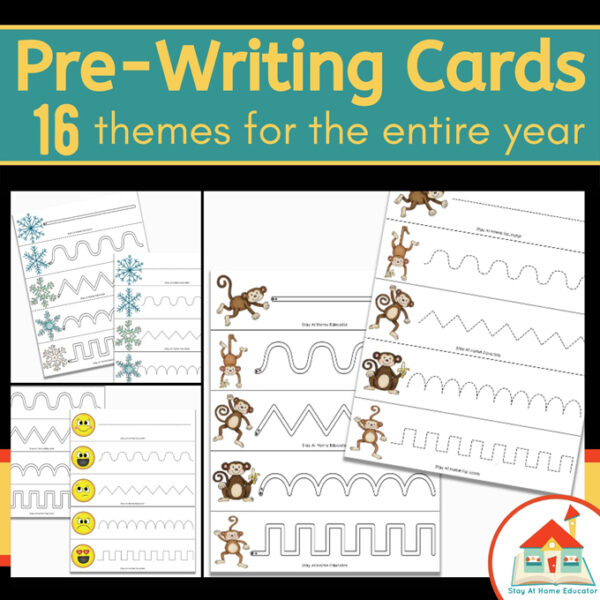 Prewriting Cards for the Entire YearOriginal price was: $16.00.$8.00Current price is: $8.00.
Prewriting Cards for the Entire YearOriginal price was: $16.00.$8.00Current price is: $8.00. -
Product on sale
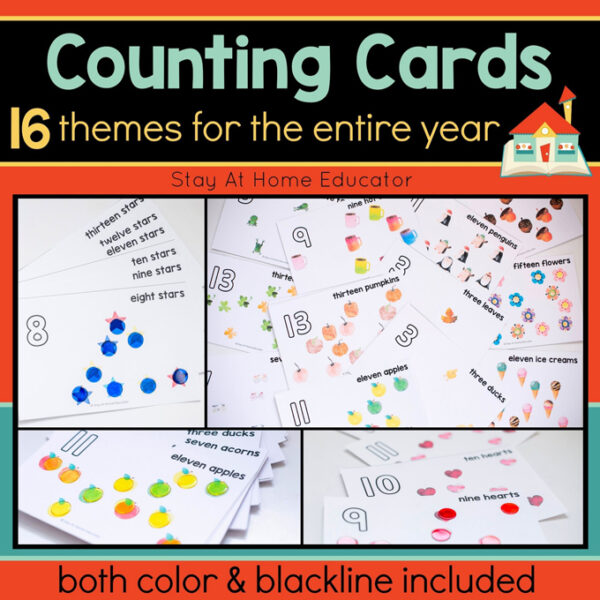 Counting Cards for the Entire Year (16 Themes)Original price was: $16.00.$10.00Current price is: $10.00.
Counting Cards for the Entire Year (16 Themes)Original price was: $16.00.$10.00Current price is: $10.00.
The Water Painting Process
Invite your children to use a pipette to make droplets of oil in the liquid watercolor that is already in the shallow pan.
The first time we did this activity, I did this step myself, instead of asking one of my kids. I found that if my preschoolers were too heavy handed with the eye dropper, we ended up with a thick layer of oil on the water. If that happens, then the paper will pick up only oil and no watercolor.
It takes delicacy, which helps preschoolers develop hand control.
For older children who are less heavy-handed, this really is an excellent activity to strengthen dexterity. And using pipettes over eye droppers allows them to make smaller drops.
You can choose to slightly mix the oil and water for a more marbleized effect, but we preferred to leave the oil in droplets on the water. Lay a sheet of heavy sketching or watercolor paper on top of the water and oil, then pull it out and place it on a drying rack or large baking sheet to dry.
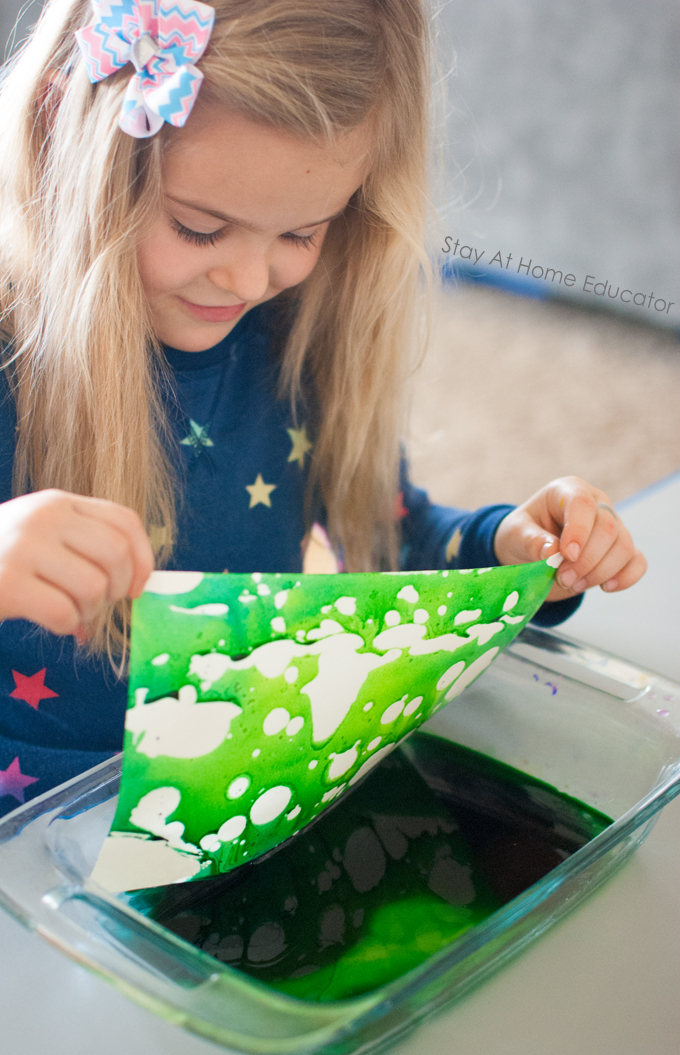
And admire the beautiful works of art! Did you ever think science projects for preschoolers could result in something so pretty?
To bring about even more vivid colors, you can invite your preschooler to use the eye droppers to drop even more liquid watercolor on the paper after you have removed it from the pan. My son noticed it first and said, “Wait, what? Why won’t it go there?” (referring to the droplets of oil on the paper).
The same effect can be achieved by painting with water form the pan, too. Or, use this as a time to add more colors. The key is to add only a little and let this fun science activity work its magic.
Related Reading
How is this a Matter and Mixtures STEAM Activity for Preschoolers?
Use this as an opportunity to delve into the process of science and art. Painting with oil is a fun art project for kids, but also a beautiful science craft that serves as a neat science experiment, too.
Enter matter and mixtures.
Here are the facts about why the oil resists the liquid watercolor, (and thus create this amazing arts and crafts project).
- Oil is less dense than water.
- That means that the molecules that make up water are packed more tightly than those in the same amount of oil, so water will always sink below the oil.
- Oil and water don’t mix because water likes itself more than oil.
- Oil is non-polar, which means it’s “afraid of water” so it doesn’t like to mix and water molecules are more attracted to other water molecules than oil molecules because they are polar. So, oil only likes non-polar molecules and water only like polar molecules. (Oil and water are snobs like that).
- Detergents like both water and oil, which is why they are so great at cleaning!
- When there are oil spills in the ocean, detergents are used to wash the oil from sea birds who have swam in the oil, saving their lives.
-
Product on sale
 Color Sorting Mats for the Entire YearOriginal price was: $16.00.$8.00Current price is: $8.00.
Color Sorting Mats for the Entire YearOriginal price was: $16.00.$8.00Current price is: $8.00. -
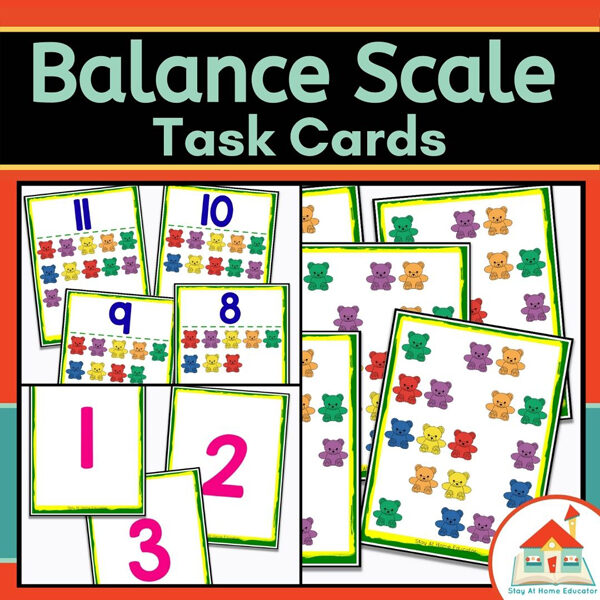 Balancing Scale and Counting Bears Task Cards$5.00
Balancing Scale and Counting Bears Task Cards$5.00
Process Art Meets Chemistry
It’s all just a little chemistry, and what a smart way to sneak science into your preschool classroom. Or your kids’ summer vacation.
After the pieces dried, I ironed the paper between two pieces of brown paper bag to lift off the extra oil.
Finally, display or use.
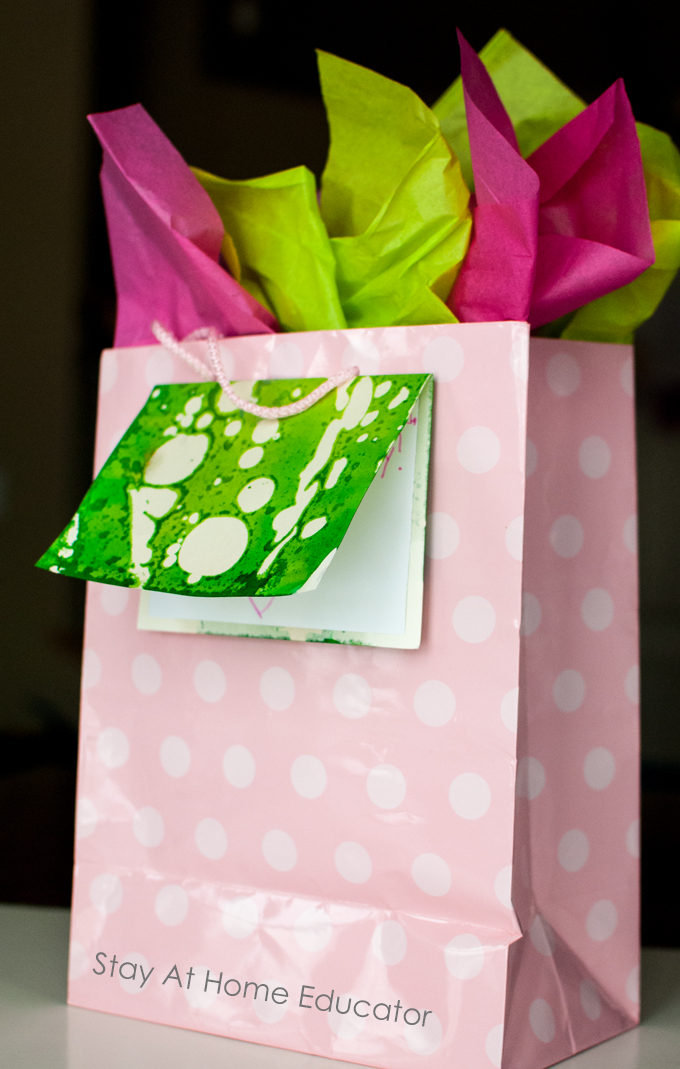
My kids made birthday and thank you cards out of them, but I also thought that a series of them framed would look really great hanging in their bedrooms! Imagine a small gallery wall of oil and water droplet paintings!
Art Lesson Plans for Preschoolers
Imagine giving kids a magical space where creativity flows freely, and they get to explore with their senses while improving their fine motor skills. Art lesson plans tailored for preschoolers open up a vibrant world of colors, shapes, and textures.
The focus is on enjoying the process and learning, without the pressure of creating something perfect.
These lesson plans often incorporate everyday items, making learning engaging and accessible. Introducing art early in children’s lives enriches their emotional, cognitive, and social development. It’s not merely about crafting art; it’s about nurturing growth through artistic exploration.
More Art and Science Activities for Kids

I’m Sarah, an educator turned stay-at-home-mama of five! I’m the owner and creator of Stay At Home Educator, a website about intentional teaching and purposeful learning in the early childhood years. I’ve taught a range of levels, from preschool to college and a little bit of everything in between. Right now my focus is teaching my children and running a preschool from my home. Credentials include: Bachelors in Art, Masters in Curriculum and Instruction.

Just found your article. I hope your still responding to comments. I am a bit confused. You said to add plain water to the dish and drop in the oil and lay the paper on top. Then you say you can stop here, but there wouldn’t be any color on the paper right? Or should we be adding the dyed water to the dish?
The oil will resist the water, whether dyed or not, so you can do it either way. You can do colored water in the pan and add the oil droplets and then the paper, or you can leave the water plain, add the oil droplets, do the paper, take it out and then add droplets of dyed water. It works either way. By adding the dyed water last, however, you have the choice to use multiple colors of water, rather than dying the pan of water all one color.
And, as a side note, having water in the pan to begin with allows you to manipulate the oil droplets, too.
This is so clever! I will be trying this with my little one.
Saw this show up on my Pinterest page and they looked too cool not to comment! Beautiful!! Yay! for cheap easy fun : )